Food Manufacturing Process and Management: A Case Study of Waterside Inn Restaurant
VerifiedAdded on 2023/06/12
|16
|5092
|335
AI Summary
This report discusses the food manufacturing process and management at Waterside Inn Restaurant. It covers different types of food production systems, key principles and methods for production and planning of food preparation, and resources required for consistent, safe, and timely food production operation. The report also includes a comparison of food preparation and production systems, evaluation of their design to meet business and customer requirements, and recommendations for standard operating procedures to maximize restaurant operations.
Contribute Materials
Your contribution can guide someone’s learning journey. Share your
documents today.
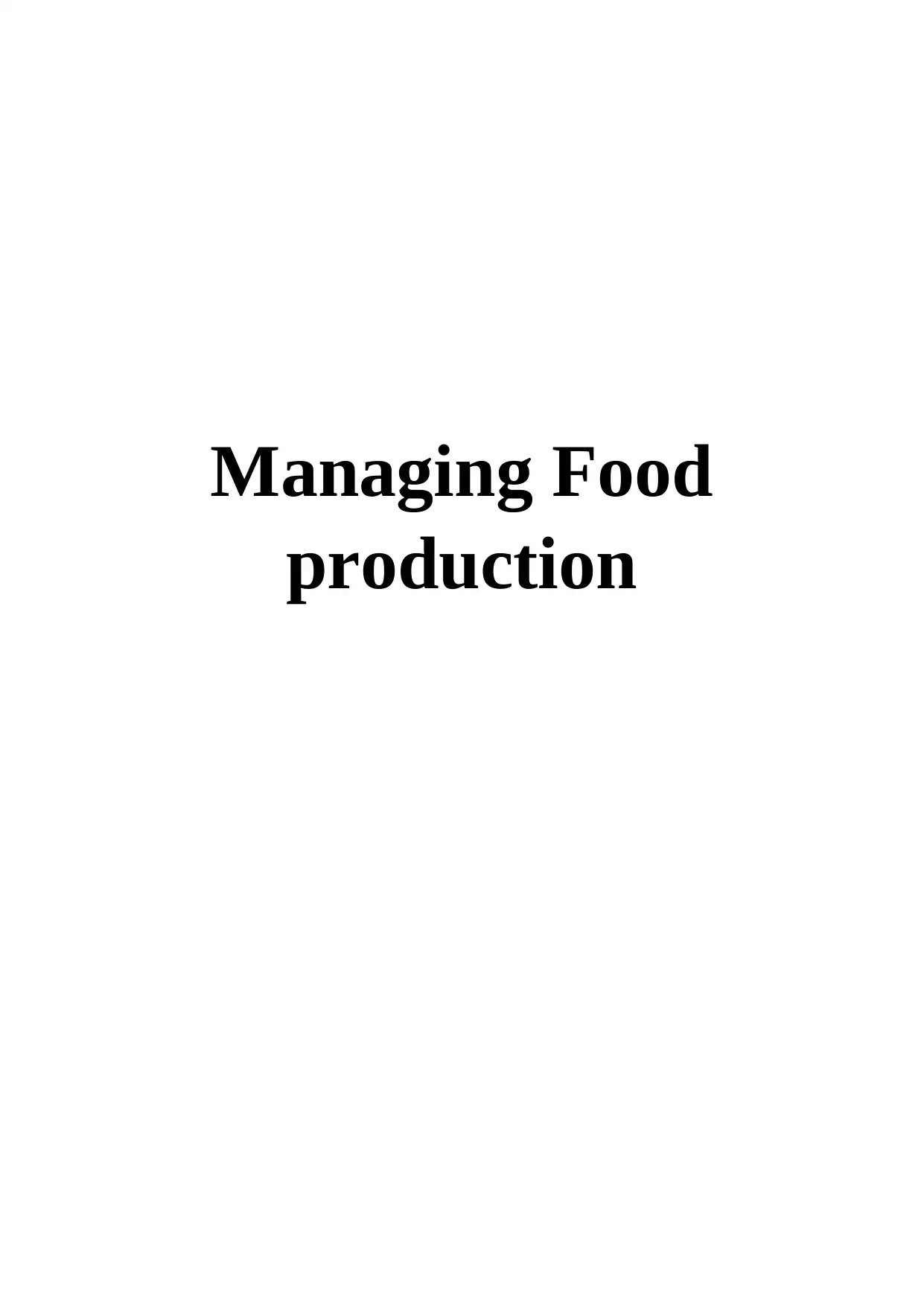
Managing Food
production
production
Secure Best Marks with AI Grader
Need help grading? Try our AI Grader for instant feedback on your assignments.
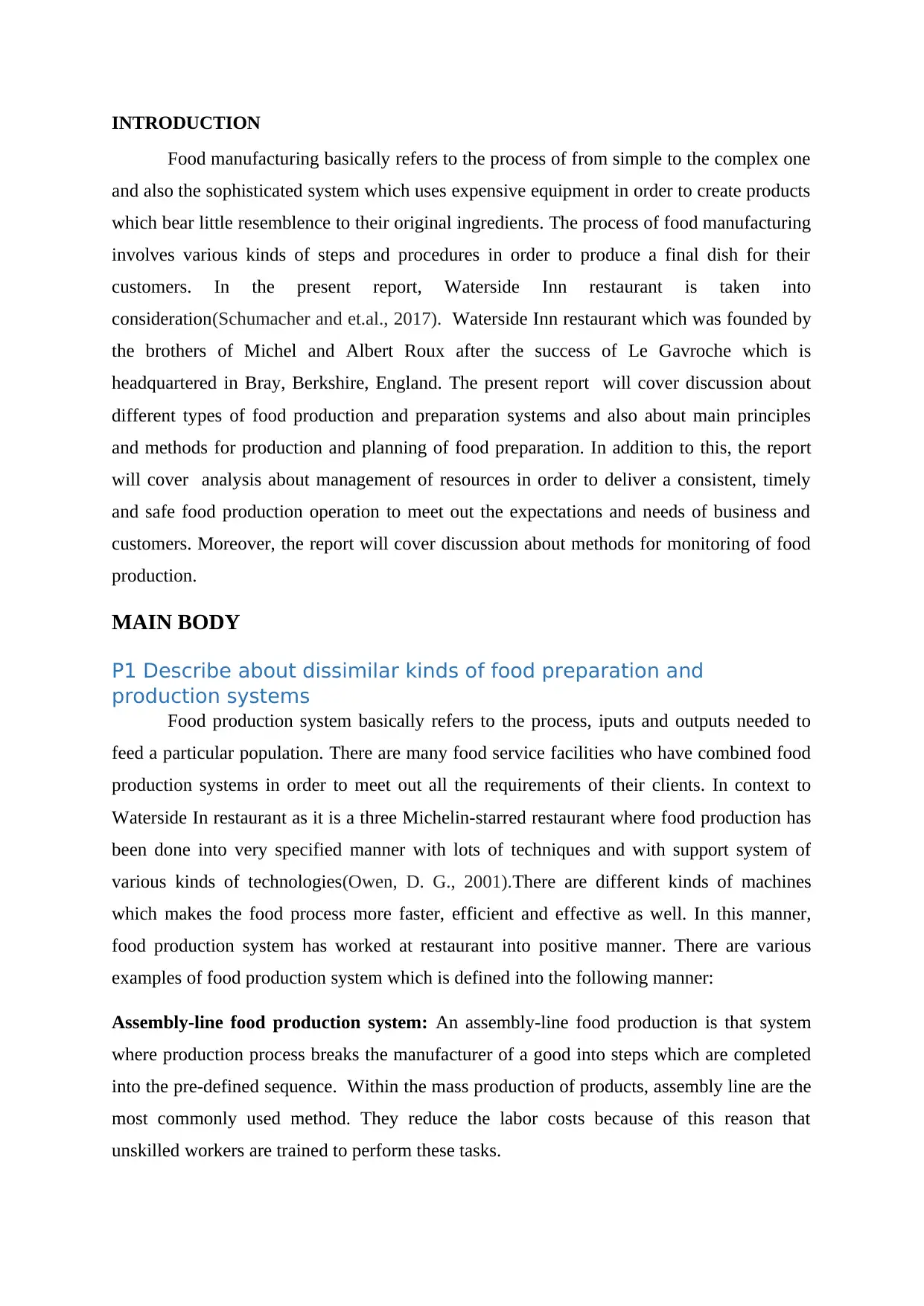
INTRODUCTION
Food manufacturing basically refers to the process of from simple to the complex one
and also the sophisticated system which uses expensive equipment in order to create products
which bear little resemblence to their original ingredients. The process of food manufacturing
involves various kinds of steps and procedures in order to produce a final dish for their
customers. In the present report, Waterside Inn restaurant is taken into
consideration(Schumacher and et.al., 2017). Waterside Inn restaurant which was founded by
the brothers of Michel and Albert Roux after the success of Le Gavroche which is
headquartered in Bray, Berkshire, England. The present report will cover discussion about
different types of food production and preparation systems and also about main principles
and methods for production and planning of food preparation. In addition to this, the report
will cover analysis about management of resources in order to deliver a consistent, timely
and safe food production operation to meet out the expectations and needs of business and
customers. Moreover, the report will cover discussion about methods for monitoring of food
production.
MAIN BODY
P1 Describe about dissimilar kinds of food preparation and
production systems
Food production system basically refers to the process, iputs and outputs needed to
feed a particular population. There are many food service facilities who have combined food
production systems in order to meet out all the requirements of their clients. In context to
Waterside In restaurant as it is a three Michelin-starred restaurant where food production has
been done into very specified manner with lots of techniques and with support system of
various kinds of technologies(Owen, D. G., 2001).There are different kinds of machines
which makes the food process more faster, efficient and effective as well. In this manner,
food production system has worked at restaurant into positive manner. There are various
examples of food production system which is defined into the following manner:
Assembly-line food production system: An assembly-line food production is that system
where production process breaks the manufacturer of a good into steps which are completed
into the pre-defined sequence. Within the mass production of products, assembly line are the
most commonly used method. They reduce the labor costs because of this reason that
unskilled workers are trained to perform these tasks.
Food manufacturing basically refers to the process of from simple to the complex one
and also the sophisticated system which uses expensive equipment in order to create products
which bear little resemblence to their original ingredients. The process of food manufacturing
involves various kinds of steps and procedures in order to produce a final dish for their
customers. In the present report, Waterside Inn restaurant is taken into
consideration(Schumacher and et.al., 2017). Waterside Inn restaurant which was founded by
the brothers of Michel and Albert Roux after the success of Le Gavroche which is
headquartered in Bray, Berkshire, England. The present report will cover discussion about
different types of food production and preparation systems and also about main principles
and methods for production and planning of food preparation. In addition to this, the report
will cover analysis about management of resources in order to deliver a consistent, timely
and safe food production operation to meet out the expectations and needs of business and
customers. Moreover, the report will cover discussion about methods for monitoring of food
production.
MAIN BODY
P1 Describe about dissimilar kinds of food preparation and
production systems
Food production system basically refers to the process, iputs and outputs needed to
feed a particular population. There are many food service facilities who have combined food
production systems in order to meet out all the requirements of their clients. In context to
Waterside In restaurant as it is a three Michelin-starred restaurant where food production has
been done into very specified manner with lots of techniques and with support system of
various kinds of technologies(Owen, D. G., 2001).There are different kinds of machines
which makes the food process more faster, efficient and effective as well. In this manner,
food production system has worked at restaurant into positive manner. There are various
examples of food production system which is defined into the following manner:
Assembly-line food production system: An assembly-line food production is that system
where production process breaks the manufacturer of a good into steps which are completed
into the pre-defined sequence. Within the mass production of products, assembly line are the
most commonly used method. They reduce the labor costs because of this reason that
unskilled workers are trained to perform these tasks.
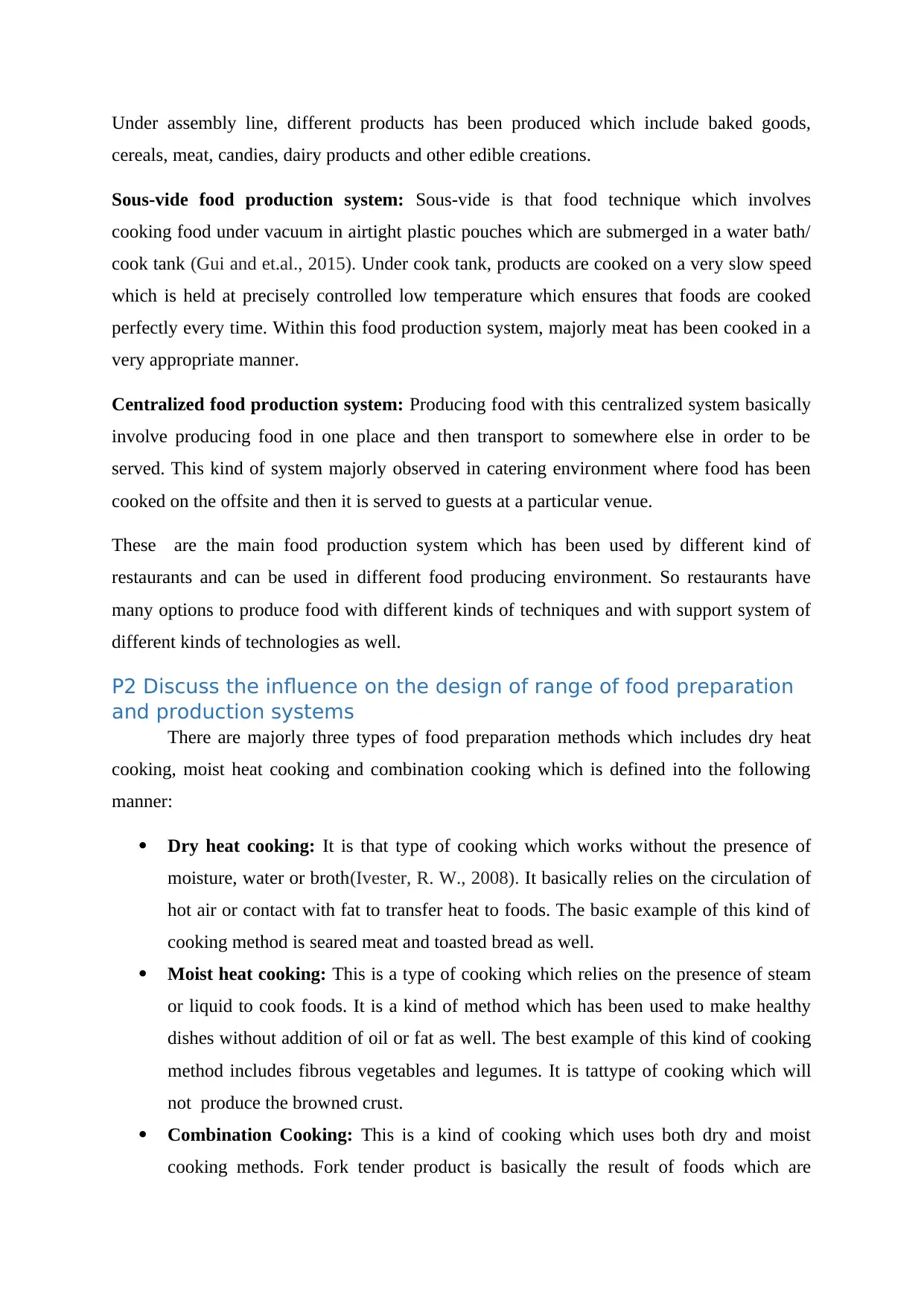
Under assembly line, different products has been produced which include baked goods,
cereals, meat, candies, dairy products and other edible creations.
Sous-vide food production system: Sous-vide is that food technique which involves
cooking food under vacuum in airtight plastic pouches which are submerged in a water bath/
cook tank (Gui and et.al., 2015). Under cook tank, products are cooked on a very slow speed
which is held at precisely controlled low temperature which ensures that foods are cooked
perfectly every time. Within this food production system, majorly meat has been cooked in a
very appropriate manner.
Centralized food production system: Producing food with this centralized system basically
involve producing food in one place and then transport to somewhere else in order to be
served. This kind of system majorly observed in catering environment where food has been
cooked on the offsite and then it is served to guests at a particular venue.
These are the main food production system which has been used by different kind of
restaurants and can be used in different food producing environment. So restaurants have
many options to produce food with different kinds of techniques and with support system of
different kinds of technologies as well.
P2 Discuss the influence on the design of range of food preparation
and production systems
There are majorly three types of food preparation methods which includes dry heat
cooking, moist heat cooking and combination cooking which is defined into the following
manner:
Dry heat cooking: It is that type of cooking which works without the presence of
moisture, water or broth(Ivester, R. W., 2008). It basically relies on the circulation of
hot air or contact with fat to transfer heat to foods. The basic example of this kind of
cooking method is seared meat and toasted bread as well.
Moist heat cooking: This is a type of cooking which relies on the presence of steam
or liquid to cook foods. It is a kind of method which has been used to make healthy
dishes without addition of oil or fat as well. The best example of this kind of cooking
method includes fibrous vegetables and legumes. It is tattype of cooking which will
not produce the browned crust.
Combination Cooking: This is a kind of cooking which uses both dry and moist
cooking methods. Fork tender product is basically the result of foods which are
cereals, meat, candies, dairy products and other edible creations.
Sous-vide food production system: Sous-vide is that food technique which involves
cooking food under vacuum in airtight plastic pouches which are submerged in a water bath/
cook tank (Gui and et.al., 2015). Under cook tank, products are cooked on a very slow speed
which is held at precisely controlled low temperature which ensures that foods are cooked
perfectly every time. Within this food production system, majorly meat has been cooked in a
very appropriate manner.
Centralized food production system: Producing food with this centralized system basically
involve producing food in one place and then transport to somewhere else in order to be
served. This kind of system majorly observed in catering environment where food has been
cooked on the offsite and then it is served to guests at a particular venue.
These are the main food production system which has been used by different kind of
restaurants and can be used in different food producing environment. So restaurants have
many options to produce food with different kinds of techniques and with support system of
different kinds of technologies as well.
P2 Discuss the influence on the design of range of food preparation
and production systems
There are majorly three types of food preparation methods which includes dry heat
cooking, moist heat cooking and combination cooking which is defined into the following
manner:
Dry heat cooking: It is that type of cooking which works without the presence of
moisture, water or broth(Ivester, R. W., 2008). It basically relies on the circulation of
hot air or contact with fat to transfer heat to foods. The basic example of this kind of
cooking method is seared meat and toasted bread as well.
Moist heat cooking: This is a type of cooking which relies on the presence of steam
or liquid to cook foods. It is a kind of method which has been used to make healthy
dishes without addition of oil or fat as well. The best example of this kind of cooking
method includes fibrous vegetables and legumes. It is tattype of cooking which will
not produce the browned crust.
Combination Cooking: This is a kind of cooking which uses both dry and moist
cooking methods. Fork tender product is basically the result of foods which are
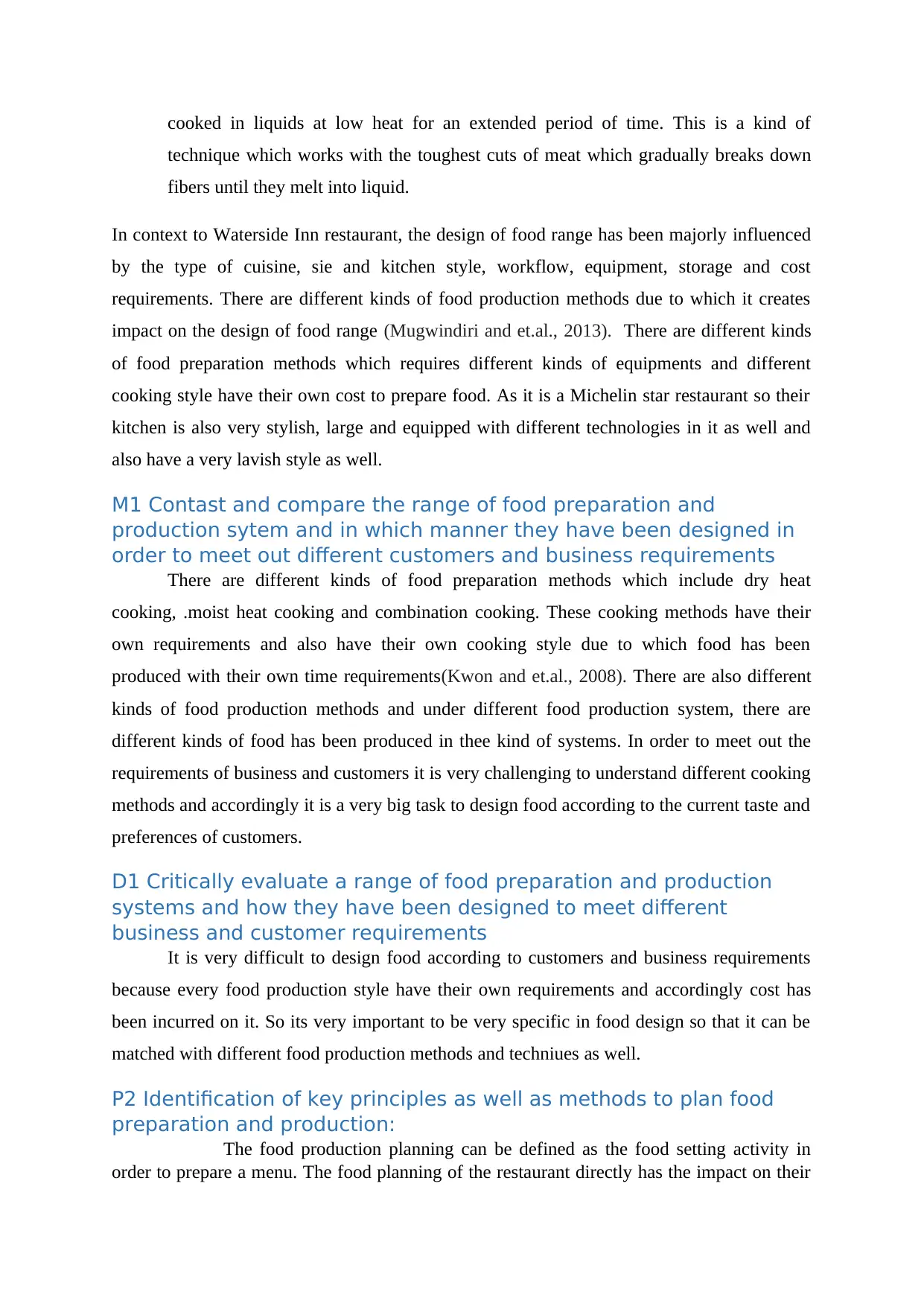
cooked in liquids at low heat for an extended period of time. This is a kind of
technique which works with the toughest cuts of meat which gradually breaks down
fibers until they melt into liquid.
In context to Waterside Inn restaurant, the design of food range has been majorly influenced
by the type of cuisine, sie and kitchen style, workflow, equipment, storage and cost
requirements. There are different kinds of food production methods due to which it creates
impact on the design of food range (Mugwindiri and et.al., 2013). There are different kinds
of food preparation methods which requires different kinds of equipments and different
cooking style have their own cost to prepare food. As it is a Michelin star restaurant so their
kitchen is also very stylish, large and equipped with different technologies in it as well and
also have a very lavish style as well.
M1 Contast and compare the range of food preparation and
production sytem and in which manner they have been designed in
order to meet out different customers and business requirements
There are different kinds of food preparation methods which include dry heat
cooking, .moist heat cooking and combination cooking. These cooking methods have their
own requirements and also have their own cooking style due to which food has been
produced with their own time requirements(Kwon and et.al., 2008). There are also different
kinds of food production methods and under different food production system, there are
different kinds of food has been produced in thee kind of systems. In order to meet out the
requirements of business and customers it is very challenging to understand different cooking
methods and accordingly it is a very big task to design food according to the current taste and
preferences of customers.
D1 Critically evaluate a range of food preparation and production
systems and how they have been designed to meet different
business and customer requirements
It is very difficult to design food according to customers and business requirements
because every food production style have their own requirements and accordingly cost has
been incurred on it. So its very important to be very specific in food design so that it can be
matched with different food production methods and techniues as well.
P2 Identification of key principles as well as methods to plan food
preparation and production:
The food production planning can be defined as the food setting activity in
order to prepare a menu. The food planning of the restaurant directly has the impact on their
technique which works with the toughest cuts of meat which gradually breaks down
fibers until they melt into liquid.
In context to Waterside Inn restaurant, the design of food range has been majorly influenced
by the type of cuisine, sie and kitchen style, workflow, equipment, storage and cost
requirements. There are different kinds of food production methods due to which it creates
impact on the design of food range (Mugwindiri and et.al., 2013). There are different kinds
of food preparation methods which requires different kinds of equipments and different
cooking style have their own cost to prepare food. As it is a Michelin star restaurant so their
kitchen is also very stylish, large and equipped with different technologies in it as well and
also have a very lavish style as well.
M1 Contast and compare the range of food preparation and
production sytem and in which manner they have been designed in
order to meet out different customers and business requirements
There are different kinds of food preparation methods which include dry heat
cooking, .moist heat cooking and combination cooking. These cooking methods have their
own requirements and also have their own cooking style due to which food has been
produced with their own time requirements(Kwon and et.al., 2008). There are also different
kinds of food production methods and under different food production system, there are
different kinds of food has been produced in thee kind of systems. In order to meet out the
requirements of business and customers it is very challenging to understand different cooking
methods and accordingly it is a very big task to design food according to the current taste and
preferences of customers.
D1 Critically evaluate a range of food preparation and production
systems and how they have been designed to meet different
business and customer requirements
It is very difficult to design food according to customers and business requirements
because every food production style have their own requirements and accordingly cost has
been incurred on it. So its very important to be very specific in food design so that it can be
matched with different food production methods and techniues as well.
P2 Identification of key principles as well as methods to plan food
preparation and production:
The food production planning can be defined as the food setting activity in
order to prepare a menu. The food planning of the restaurant directly has the impact on their
Secure Best Marks with AI Grader
Need help grading? Try our AI Grader for instant feedback on your assignments.
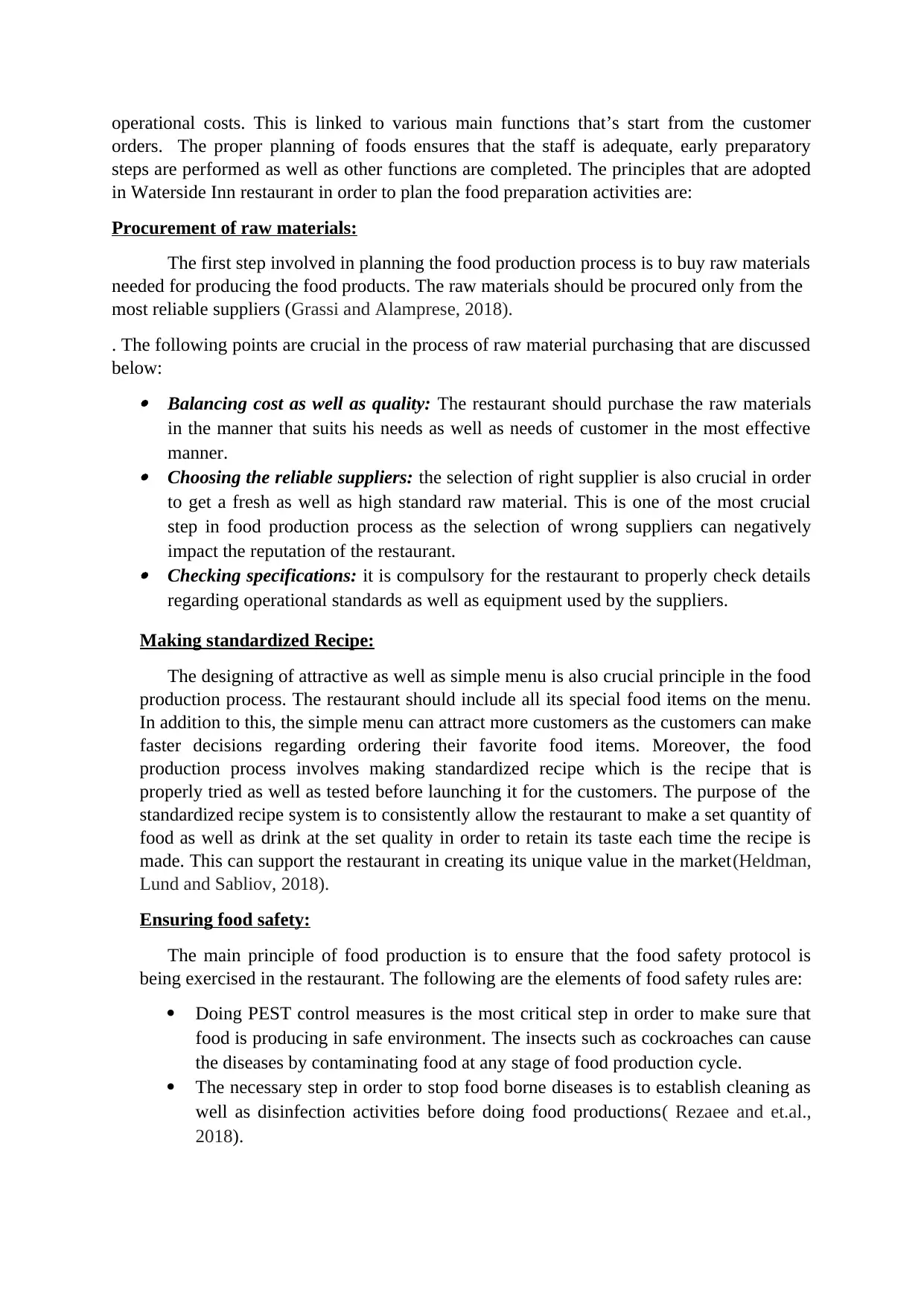
operational costs. This is linked to various main functions that’s start from the customer
orders. The proper planning of foods ensures that the staff is adequate, early preparatory
steps are performed as well as other functions are completed. The principles that are adopted
in Waterside Inn restaurant in order to plan the food preparation activities are:
Procurement of raw materials:
The first step involved in planning the food production process is to buy raw materials
needed for producing the food products. The raw materials should be procured only from the
most reliable suppliers (Grassi and Alamprese, 2018).
. The following points are crucial in the process of raw material purchasing that are discussed
below: Balancing cost as well as quality: The restaurant should purchase the raw materials
in the manner that suits his needs as well as needs of customer in the most effective
manner.
Choosing the reliable suppliers: the selection of right supplier is also crucial in order
to get a fresh as well as high standard raw material. This is one of the most crucial
step in food production process as the selection of wrong suppliers can negatively
impact the reputation of the restaurant.
Checking specifications: it is compulsory for the restaurant to properly check details
regarding operational standards as well as equipment used by the suppliers.
Making standardized Recipe:
The designing of attractive as well as simple menu is also crucial principle in the food
production process. The restaurant should include all its special food items on the menu.
In addition to this, the simple menu can attract more customers as the customers can make
faster decisions regarding ordering their favorite food items. Moreover, the food
production process involves making standardized recipe which is the recipe that is
properly tried as well as tested before launching it for the customers. The purpose of the
standardized recipe system is to consistently allow the restaurant to make a set quantity of
food as well as drink at the set quality in order to retain its taste each time the recipe is
made. This can support the restaurant in creating its unique value in the market(Heldman,
Lund and Sabliov, 2018).
Ensuring food safety:
The main principle of food production is to ensure that the food safety protocol is
being exercised in the restaurant. The following are the elements of food safety rules are:
Doing PEST control measures is the most critical step in order to make sure that
food is producing in safe environment. The insects such as cockroaches can cause
the diseases by contaminating food at any stage of food production cycle.
The necessary step in order to stop food borne diseases is to establish cleaning as
well as disinfection activities before doing food productions( Rezaee and et.al.,
2018).
orders. The proper planning of foods ensures that the staff is adequate, early preparatory
steps are performed as well as other functions are completed. The principles that are adopted
in Waterside Inn restaurant in order to plan the food preparation activities are:
Procurement of raw materials:
The first step involved in planning the food production process is to buy raw materials
needed for producing the food products. The raw materials should be procured only from the
most reliable suppliers (Grassi and Alamprese, 2018).
. The following points are crucial in the process of raw material purchasing that are discussed
below: Balancing cost as well as quality: The restaurant should purchase the raw materials
in the manner that suits his needs as well as needs of customer in the most effective
manner.
Choosing the reliable suppliers: the selection of right supplier is also crucial in order
to get a fresh as well as high standard raw material. This is one of the most crucial
step in food production process as the selection of wrong suppliers can negatively
impact the reputation of the restaurant.
Checking specifications: it is compulsory for the restaurant to properly check details
regarding operational standards as well as equipment used by the suppliers.
Making standardized Recipe:
The designing of attractive as well as simple menu is also crucial principle in the food
production process. The restaurant should include all its special food items on the menu.
In addition to this, the simple menu can attract more customers as the customers can make
faster decisions regarding ordering their favorite food items. Moreover, the food
production process involves making standardized recipe which is the recipe that is
properly tried as well as tested before launching it for the customers. The purpose of the
standardized recipe system is to consistently allow the restaurant to make a set quantity of
food as well as drink at the set quality in order to retain its taste each time the recipe is
made. This can support the restaurant in creating its unique value in the market(Heldman,
Lund and Sabliov, 2018).
Ensuring food safety:
The main principle of food production is to ensure that the food safety protocol is
being exercised in the restaurant. The following are the elements of food safety rules are:
Doing PEST control measures is the most critical step in order to make sure that
food is producing in safe environment. The insects such as cockroaches can cause
the diseases by contaminating food at any stage of food production cycle.
The necessary step in order to stop food borne diseases is to establish cleaning as
well as disinfection activities before doing food productions( Rezaee and et.al.,
2018).
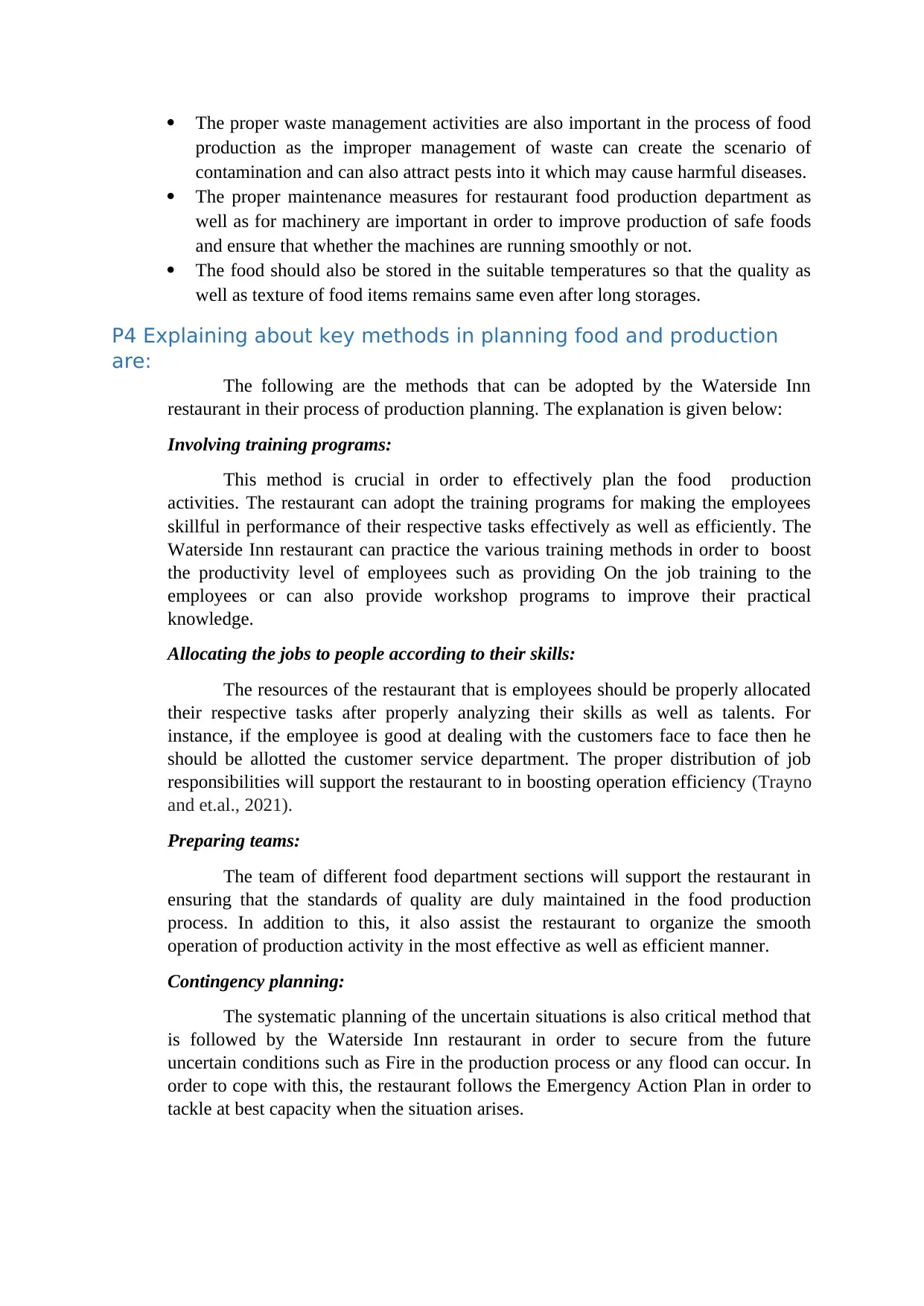
The proper waste management activities are also important in the process of food
production as the improper management of waste can create the scenario of
contamination and can also attract pests into it which may cause harmful diseases.
The proper maintenance measures for restaurant food production department as
well as for machinery are important in order to improve production of safe foods
and ensure that whether the machines are running smoothly or not.
The food should also be stored in the suitable temperatures so that the quality as
well as texture of food items remains same even after long storages.
P4 Explaining about key methods in planning food and production
are:
The following are the methods that can be adopted by the Waterside Inn
restaurant in their process of production planning. The explanation is given below:
Involving training programs:
This method is crucial in order to effectively plan the food production
activities. The restaurant can adopt the training programs for making the employees
skillful in performance of their respective tasks effectively as well as efficiently. The
Waterside Inn restaurant can practice the various training methods in order to boost
the productivity level of employees such as providing On the job training to the
employees or can also provide workshop programs to improve their practical
knowledge.
Allocating the jobs to people according to their skills:
The resources of the restaurant that is employees should be properly allocated
their respective tasks after properly analyzing their skills as well as talents. For
instance, if the employee is good at dealing with the customers face to face then he
should be allotted the customer service department. The proper distribution of job
responsibilities will support the restaurant to in boosting operation efficiency (Trayno
and et.al., 2021).
Preparing teams:
The team of different food department sections will support the restaurant in
ensuring that the standards of quality are duly maintained in the food production
process. In addition to this, it also assist the restaurant to organize the smooth
operation of production activity in the most effective as well as efficient manner.
Contingency planning:
The systematic planning of the uncertain situations is also critical method that
is followed by the Waterside Inn restaurant in order to secure from the future
uncertain conditions such as Fire in the production process or any flood can occur. In
order to cope with this, the restaurant follows the Emergency Action Plan in order to
tackle at best capacity when the situation arises.
production as the improper management of waste can create the scenario of
contamination and can also attract pests into it which may cause harmful diseases.
The proper maintenance measures for restaurant food production department as
well as for machinery are important in order to improve production of safe foods
and ensure that whether the machines are running smoothly or not.
The food should also be stored in the suitable temperatures so that the quality as
well as texture of food items remains same even after long storages.
P4 Explaining about key methods in planning food and production
are:
The following are the methods that can be adopted by the Waterside Inn
restaurant in their process of production planning. The explanation is given below:
Involving training programs:
This method is crucial in order to effectively plan the food production
activities. The restaurant can adopt the training programs for making the employees
skillful in performance of their respective tasks effectively as well as efficiently. The
Waterside Inn restaurant can practice the various training methods in order to boost
the productivity level of employees such as providing On the job training to the
employees or can also provide workshop programs to improve their practical
knowledge.
Allocating the jobs to people according to their skills:
The resources of the restaurant that is employees should be properly allocated
their respective tasks after properly analyzing their skills as well as talents. For
instance, if the employee is good at dealing with the customers face to face then he
should be allotted the customer service department. The proper distribution of job
responsibilities will support the restaurant to in boosting operation efficiency (Trayno
and et.al., 2021).
Preparing teams:
The team of different food department sections will support the restaurant in
ensuring that the standards of quality are duly maintained in the food production
process. In addition to this, it also assist the restaurant to organize the smooth
operation of production activity in the most effective as well as efficient manner.
Contingency planning:
The systematic planning of the uncertain situations is also critical method that
is followed by the Waterside Inn restaurant in order to secure from the future
uncertain conditions such as Fire in the production process or any flood can occur. In
order to cope with this, the restaurant follows the Emergency Action Plan in order to
tackle at best capacity when the situation arises.
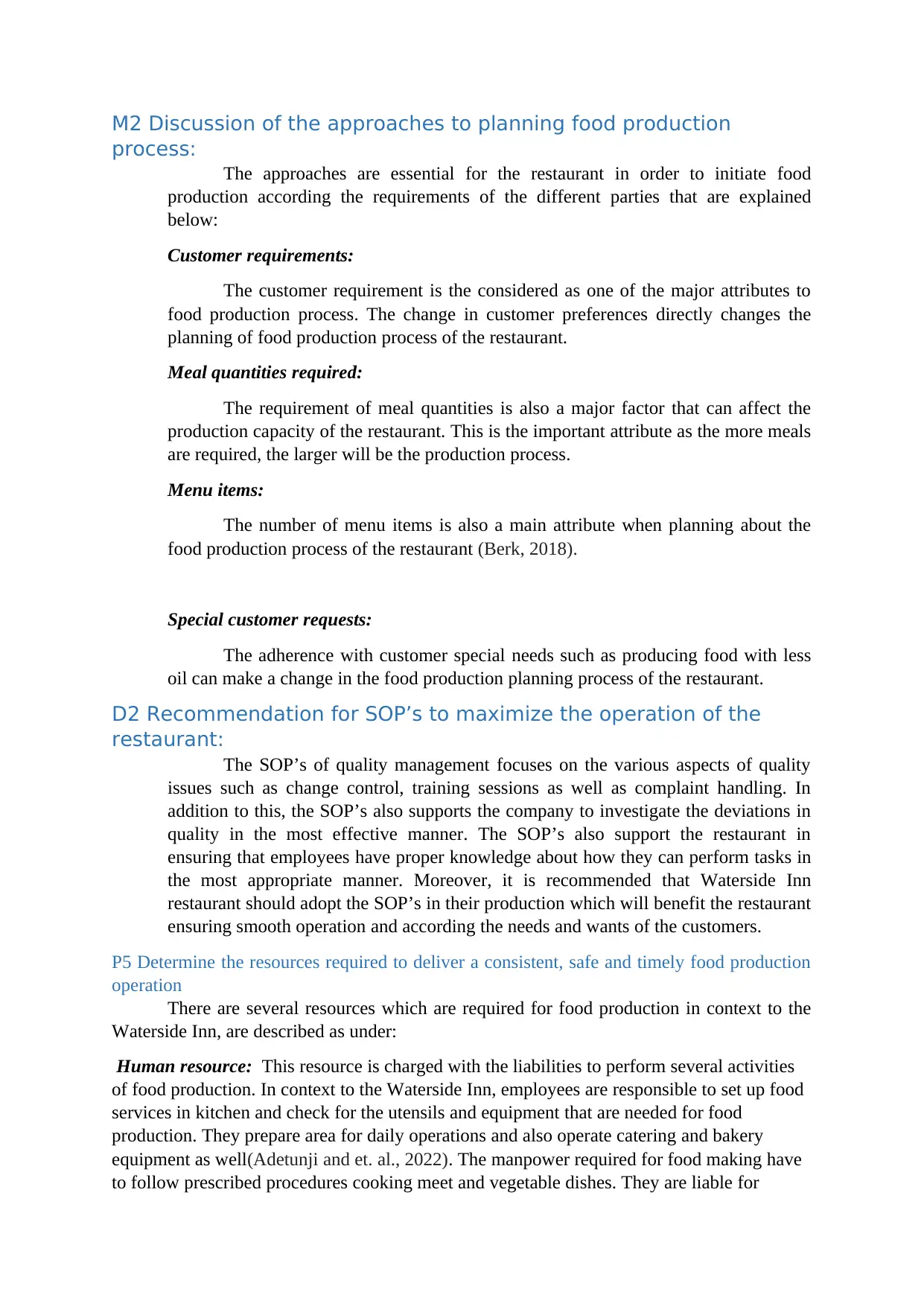
M2 Discussion of the approaches to planning food production
process:
The approaches are essential for the restaurant in order to initiate food
production according the requirements of the different parties that are explained
below:
Customer requirements:
The customer requirement is the considered as one of the major attributes to
food production process. The change in customer preferences directly changes the
planning of food production process of the restaurant.
Meal quantities required:
The requirement of meal quantities is also a major factor that can affect the
production capacity of the restaurant. This is the important attribute as the more meals
are required, the larger will be the production process.
Menu items:
The number of menu items is also a main attribute when planning about the
food production process of the restaurant (Berk, 2018).
Special customer requests:
The adherence with customer special needs such as producing food with less
oil can make a change in the food production planning process of the restaurant.
D2 Recommendation for SOP’s to maximize the operation of the
restaurant:
The SOP’s of quality management focuses on the various aspects of quality
issues such as change control, training sessions as well as complaint handling. In
addition to this, the SOP’s also supports the company to investigate the deviations in
quality in the most effective manner. The SOP’s also support the restaurant in
ensuring that employees have proper knowledge about how they can perform tasks in
the most appropriate manner. Moreover, it is recommended that Waterside Inn
restaurant should adopt the SOP’s in their production which will benefit the restaurant
ensuring smooth operation and according the needs and wants of the customers.
P5 Determine the resources required to deliver a consistent, safe and timely food production
operation
There are several resources which are required for food production in context to the
Waterside Inn, are described as under:
Human resource: This resource is charged with the liabilities to perform several activities
of food production. In context to the Waterside Inn, employees are responsible to set up food
services in kitchen and check for the utensils and equipment that are needed for food
production. They prepare area for daily operations and also operate catering and bakery
equipment as well(Adetunji and et. al., 2022). The manpower required for food making have
to follow prescribed procedures cooking meet and vegetable dishes. They are liable for
process:
The approaches are essential for the restaurant in order to initiate food
production according the requirements of the different parties that are explained
below:
Customer requirements:
The customer requirement is the considered as one of the major attributes to
food production process. The change in customer preferences directly changes the
planning of food production process of the restaurant.
Meal quantities required:
The requirement of meal quantities is also a major factor that can affect the
production capacity of the restaurant. This is the important attribute as the more meals
are required, the larger will be the production process.
Menu items:
The number of menu items is also a main attribute when planning about the
food production process of the restaurant (Berk, 2018).
Special customer requests:
The adherence with customer special needs such as producing food with less
oil can make a change in the food production planning process of the restaurant.
D2 Recommendation for SOP’s to maximize the operation of the
restaurant:
The SOP’s of quality management focuses on the various aspects of quality
issues such as change control, training sessions as well as complaint handling. In
addition to this, the SOP’s also supports the company to investigate the deviations in
quality in the most effective manner. The SOP’s also support the restaurant in
ensuring that employees have proper knowledge about how they can perform tasks in
the most appropriate manner. Moreover, it is recommended that Waterside Inn
restaurant should adopt the SOP’s in their production which will benefit the restaurant
ensuring smooth operation and according the needs and wants of the customers.
P5 Determine the resources required to deliver a consistent, safe and timely food production
operation
There are several resources which are required for food production in context to the
Waterside Inn, are described as under:
Human resource: This resource is charged with the liabilities to perform several activities
of food production. In context to the Waterside Inn, employees are responsible to set up food
services in kitchen and check for the utensils and equipment that are needed for food
production. They prepare area for daily operations and also operate catering and bakery
equipment as well(Adetunji and et. al., 2022). The manpower required for food making have
to follow prescribed procedures cooking meet and vegetable dishes. They are liable for
Paraphrase This Document
Need a fresh take? Get an instant paraphrase of this document with our AI Paraphraser
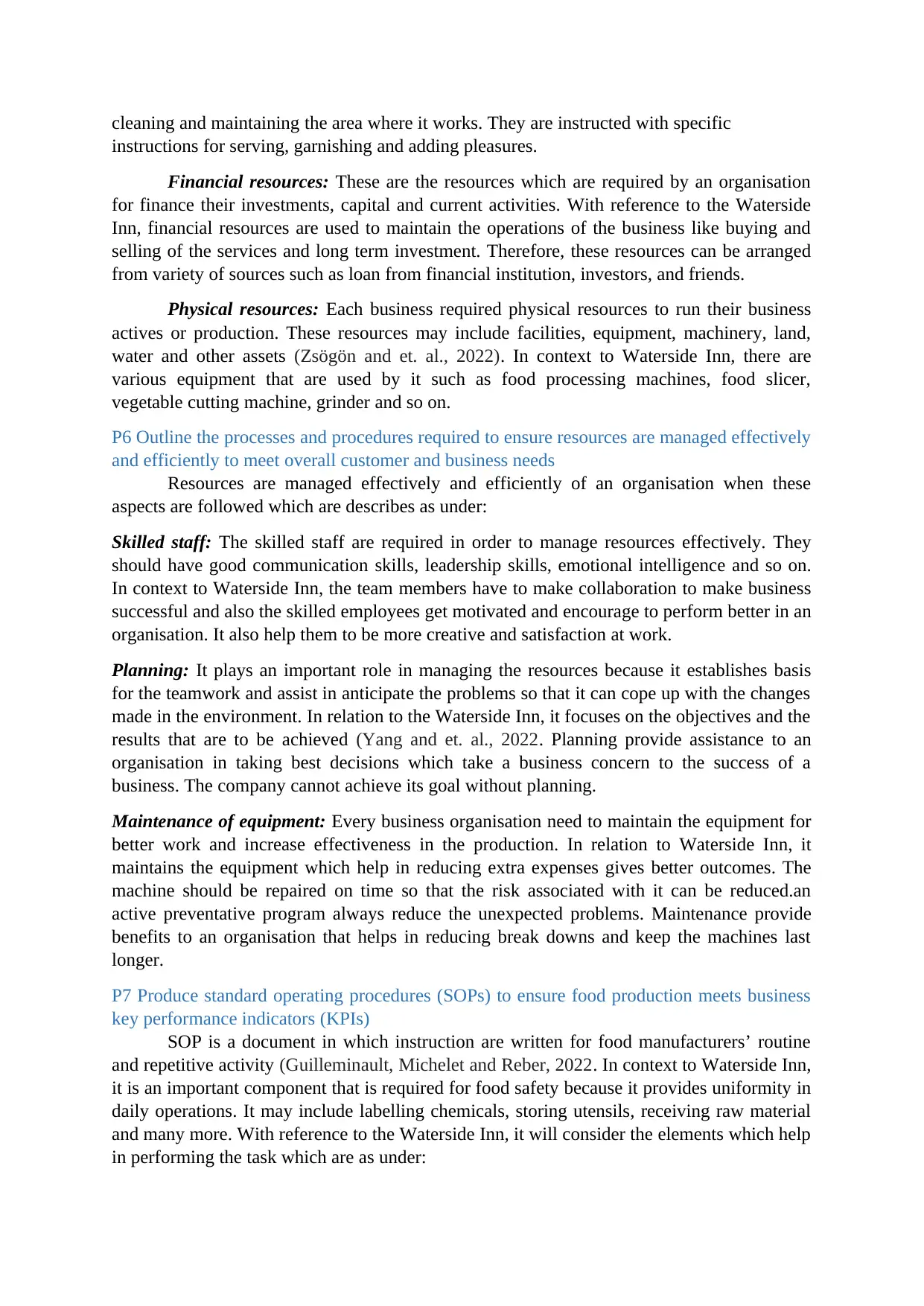
cleaning and maintaining the area where it works. They are instructed with specific
instructions for serving, garnishing and adding pleasures.
Financial resources: These are the resources which are required by an organisation
for finance their investments, capital and current activities. With reference to the Waterside
Inn, financial resources are used to maintain the operations of the business like buying and
selling of the services and long term investment. Therefore, these resources can be arranged
from variety of sources such as loan from financial institution, investors, and friends.
Physical resources: Each business required physical resources to run their business
actives or production. These resources may include facilities, equipment, machinery, land,
water and other assets (Zsögön and et. al., 2022). In context to Waterside Inn, there are
various equipment that are used by it such as food processing machines, food slicer,
vegetable cutting machine, grinder and so on.
P6 Outline the processes and procedures required to ensure resources are managed effectively
and efficiently to meet overall customer and business needs
Resources are managed effectively and efficiently of an organisation when these
aspects are followed which are describes as under:
Skilled staff: The skilled staff are required in order to manage resources effectively. They
should have good communication skills, leadership skills, emotional intelligence and so on.
In context to Waterside Inn, the team members have to make collaboration to make business
successful and also the skilled employees get motivated and encourage to perform better in an
organisation. It also help them to be more creative and satisfaction at work.
Planning: It plays an important role in managing the resources because it establishes basis
for the teamwork and assist in anticipate the problems so that it can cope up with the changes
made in the environment. In relation to the Waterside Inn, it focuses on the objectives and the
results that are to be achieved (Yang and et. al., 2022. Planning provide assistance to an
organisation in taking best decisions which take a business concern to the success of a
business. The company cannot achieve its goal without planning.
Maintenance of equipment: Every business organisation need to maintain the equipment for
better work and increase effectiveness in the production. In relation to Waterside Inn, it
maintains the equipment which help in reducing extra expenses gives better outcomes. The
machine should be repaired on time so that the risk associated with it can be reduced.an
active preventative program always reduce the unexpected problems. Maintenance provide
benefits to an organisation that helps in reducing break downs and keep the machines last
longer.
P7 Produce standard operating procedures (SOPs) to ensure food production meets business
key performance indicators (KPIs)
SOP is a document in which instruction are written for food manufacturers’ routine
and repetitive activity (Guilleminault, Michelet and Reber, 2022. In context to Waterside Inn,
it is an important component that is required for food safety because it provides uniformity in
daily operations. It may include labelling chemicals, storing utensils, receiving raw material
and many more. With reference to the Waterside Inn, it will consider the elements which help
in performing the task which are as under:
instructions for serving, garnishing and adding pleasures.
Financial resources: These are the resources which are required by an organisation
for finance their investments, capital and current activities. With reference to the Waterside
Inn, financial resources are used to maintain the operations of the business like buying and
selling of the services and long term investment. Therefore, these resources can be arranged
from variety of sources such as loan from financial institution, investors, and friends.
Physical resources: Each business required physical resources to run their business
actives or production. These resources may include facilities, equipment, machinery, land,
water and other assets (Zsögön and et. al., 2022). In context to Waterside Inn, there are
various equipment that are used by it such as food processing machines, food slicer,
vegetable cutting machine, grinder and so on.
P6 Outline the processes and procedures required to ensure resources are managed effectively
and efficiently to meet overall customer and business needs
Resources are managed effectively and efficiently of an organisation when these
aspects are followed which are describes as under:
Skilled staff: The skilled staff are required in order to manage resources effectively. They
should have good communication skills, leadership skills, emotional intelligence and so on.
In context to Waterside Inn, the team members have to make collaboration to make business
successful and also the skilled employees get motivated and encourage to perform better in an
organisation. It also help them to be more creative and satisfaction at work.
Planning: It plays an important role in managing the resources because it establishes basis
for the teamwork and assist in anticipate the problems so that it can cope up with the changes
made in the environment. In relation to the Waterside Inn, it focuses on the objectives and the
results that are to be achieved (Yang and et. al., 2022. Planning provide assistance to an
organisation in taking best decisions which take a business concern to the success of a
business. The company cannot achieve its goal without planning.
Maintenance of equipment: Every business organisation need to maintain the equipment for
better work and increase effectiveness in the production. In relation to Waterside Inn, it
maintains the equipment which help in reducing extra expenses gives better outcomes. The
machine should be repaired on time so that the risk associated with it can be reduced.an
active preventative program always reduce the unexpected problems. Maintenance provide
benefits to an organisation that helps in reducing break downs and keep the machines last
longer.
P7 Produce standard operating procedures (SOPs) to ensure food production meets business
key performance indicators (KPIs)
SOP is a document in which instruction are written for food manufacturers’ routine
and repetitive activity (Guilleminault, Michelet and Reber, 2022. In context to Waterside Inn,
it is an important component that is required for food safety because it provides uniformity in
daily operations. It may include labelling chemicals, storing utensils, receiving raw material
and many more. With reference to the Waterside Inn, it will consider the elements which help
in performing the task which are as under:
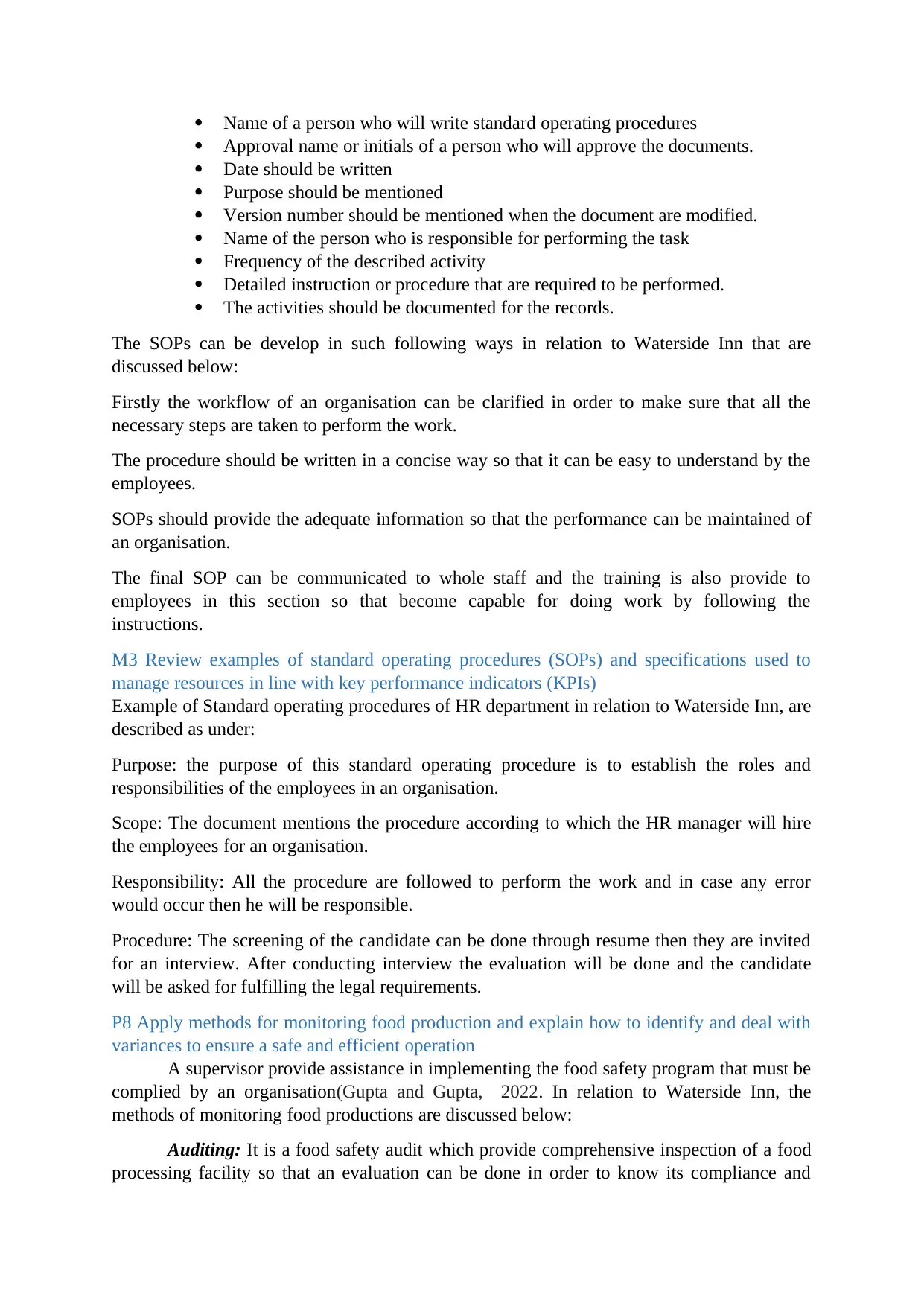
Name of a person who will write standard operating procedures
Approval name or initials of a person who will approve the documents.
Date should be written
Purpose should be mentioned
Version number should be mentioned when the document are modified.
Name of the person who is responsible for performing the task
Frequency of the described activity
Detailed instruction or procedure that are required to be performed.
The activities should be documented for the records.
The SOPs can be develop in such following ways in relation to Waterside Inn that are
discussed below:
Firstly the workflow of an organisation can be clarified in order to make sure that all the
necessary steps are taken to perform the work.
The procedure should be written in a concise way so that it can be easy to understand by the
employees.
SOPs should provide the adequate information so that the performance can be maintained of
an organisation.
The final SOP can be communicated to whole staff and the training is also provide to
employees in this section so that become capable for doing work by following the
instructions.
M3 Review examples of standard operating procedures (SOPs) and specifications used to
manage resources in line with key performance indicators (KPIs)
Example of Standard operating procedures of HR department in relation to Waterside Inn, are
described as under:
Purpose: the purpose of this standard operating procedure is to establish the roles and
responsibilities of the employees in an organisation.
Scope: The document mentions the procedure according to which the HR manager will hire
the employees for an organisation.
Responsibility: All the procedure are followed to perform the work and in case any error
would occur then he will be responsible.
Procedure: The screening of the candidate can be done through resume then they are invited
for an interview. After conducting interview the evaluation will be done and the candidate
will be asked for fulfilling the legal requirements.
P8 Apply methods for monitoring food production and explain how to identify and deal with
variances to ensure a safe and efficient operation
A supervisor provide assistance in implementing the food safety program that must be
complied by an organisation(Gupta and Gupta, 2022. In relation to Waterside Inn, the
methods of monitoring food productions are discussed below:
Auditing: It is a food safety audit which provide comprehensive inspection of a food
processing facility so that an evaluation can be done in order to know its compliance and
Approval name or initials of a person who will approve the documents.
Date should be written
Purpose should be mentioned
Version number should be mentioned when the document are modified.
Name of the person who is responsible for performing the task
Frequency of the described activity
Detailed instruction or procedure that are required to be performed.
The activities should be documented for the records.
The SOPs can be develop in such following ways in relation to Waterside Inn that are
discussed below:
Firstly the workflow of an organisation can be clarified in order to make sure that all the
necessary steps are taken to perform the work.
The procedure should be written in a concise way so that it can be easy to understand by the
employees.
SOPs should provide the adequate information so that the performance can be maintained of
an organisation.
The final SOP can be communicated to whole staff and the training is also provide to
employees in this section so that become capable for doing work by following the
instructions.
M3 Review examples of standard operating procedures (SOPs) and specifications used to
manage resources in line with key performance indicators (KPIs)
Example of Standard operating procedures of HR department in relation to Waterside Inn, are
described as under:
Purpose: the purpose of this standard operating procedure is to establish the roles and
responsibilities of the employees in an organisation.
Scope: The document mentions the procedure according to which the HR manager will hire
the employees for an organisation.
Responsibility: All the procedure are followed to perform the work and in case any error
would occur then he will be responsible.
Procedure: The screening of the candidate can be done through resume then they are invited
for an interview. After conducting interview the evaluation will be done and the candidate
will be asked for fulfilling the legal requirements.
P8 Apply methods for monitoring food production and explain how to identify and deal with
variances to ensure a safe and efficient operation
A supervisor provide assistance in implementing the food safety program that must be
complied by an organisation(Gupta and Gupta, 2022. In relation to Waterside Inn, the
methods of monitoring food productions are discussed below:
Auditing: It is a food safety audit which provide comprehensive inspection of a food
processing facility so that an evaluation can be done in order to know its compliance and
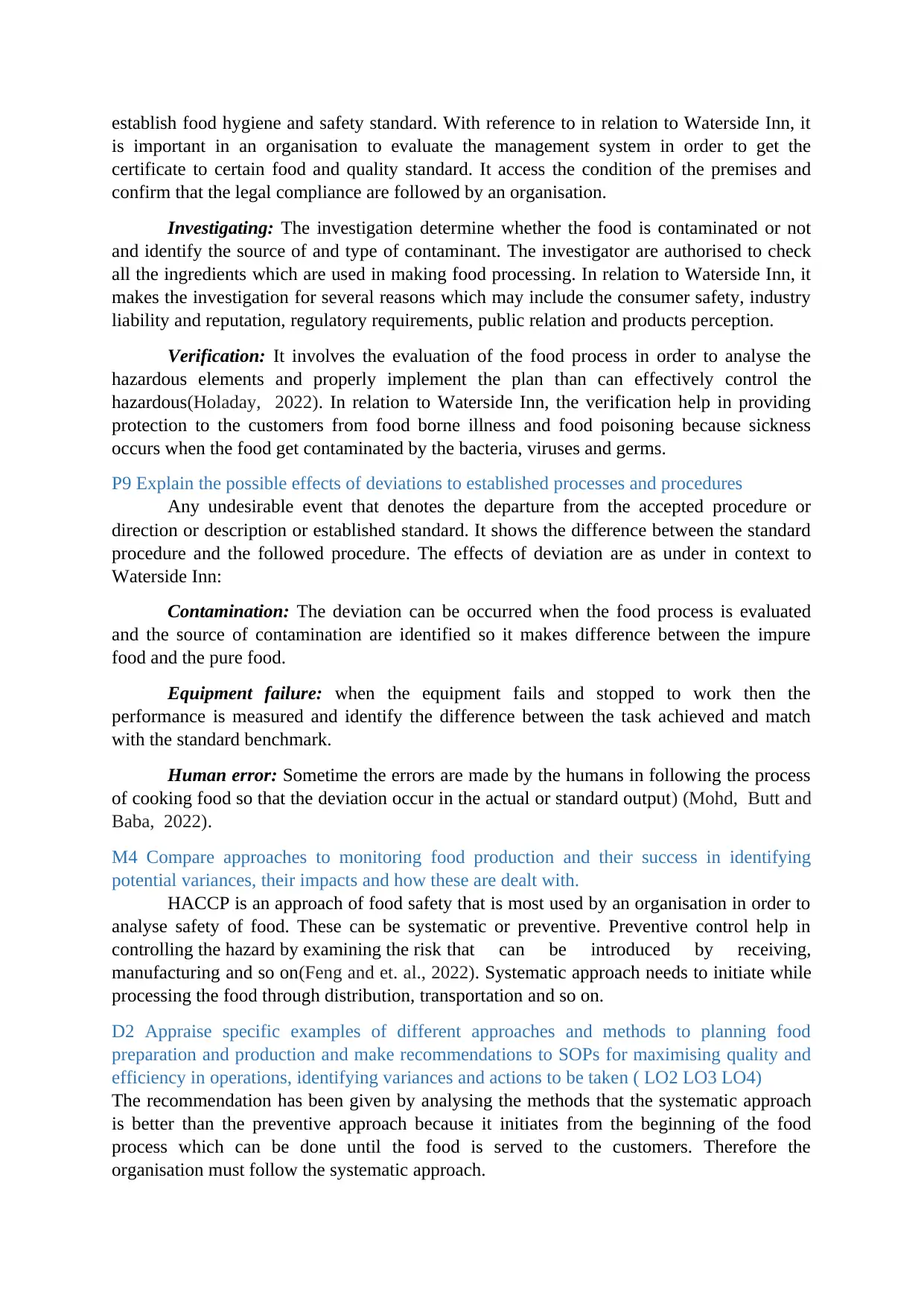
establish food hygiene and safety standard. With reference to in relation to Waterside Inn, it
is important in an organisation to evaluate the management system in order to get the
certificate to certain food and quality standard. It access the condition of the premises and
confirm that the legal compliance are followed by an organisation.
Investigating: The investigation determine whether the food is contaminated or not
and identify the source of and type of contaminant. The investigator are authorised to check
all the ingredients which are used in making food processing. In relation to Waterside Inn, it
makes the investigation for several reasons which may include the consumer safety, industry
liability and reputation, regulatory requirements, public relation and products perception.
Verification: It involves the evaluation of the food process in order to analyse the
hazardous elements and properly implement the plan than can effectively control the
hazardous(Holaday, 2022). In relation to Waterside Inn, the verification help in providing
protection to the customers from food borne illness and food poisoning because sickness
occurs when the food get contaminated by the bacteria, viruses and germs.
P9 Explain the possible effects of deviations to established processes and procedures
Any undesirable event that denotes the departure from the accepted procedure or
direction or description or established standard. It shows the difference between the standard
procedure and the followed procedure. The effects of deviation are as under in context to
Waterside Inn:
Contamination: The deviation can be occurred when the food process is evaluated
and the source of contamination are identified so it makes difference between the impure
food and the pure food.
Equipment failure: when the equipment fails and stopped to work then the
performance is measured and identify the difference between the task achieved and match
with the standard benchmark.
Human error: Sometime the errors are made by the humans in following the process
of cooking food so that the deviation occur in the actual or standard output) (Mohd, Butt and
Baba, 2022).
M4 Compare approaches to monitoring food production and their success in identifying
potential variances, their impacts and how these are dealt with.
HACCP is an approach of food safety that is most used by an organisation in order to
analyse safety of food. These can be systematic or preventive. Preventive control help in
controlling the hazard by examining the risk that can be introduced by receiving,
manufacturing and so on(Feng and et. al., 2022). Systematic approach needs to initiate while
processing the food through distribution, transportation and so on.
D2 Appraise specific examples of different approaches and methods to planning food
preparation and production and make recommendations to SOPs for maximising quality and
efficiency in operations, identifying variances and actions to be taken ( LO2 LO3 LO4)
The recommendation has been given by analysing the methods that the systematic approach
is better than the preventive approach because it initiates from the beginning of the food
process which can be done until the food is served to the customers. Therefore the
organisation must follow the systematic approach.
is important in an organisation to evaluate the management system in order to get the
certificate to certain food and quality standard. It access the condition of the premises and
confirm that the legal compliance are followed by an organisation.
Investigating: The investigation determine whether the food is contaminated or not
and identify the source of and type of contaminant. The investigator are authorised to check
all the ingredients which are used in making food processing. In relation to Waterside Inn, it
makes the investigation for several reasons which may include the consumer safety, industry
liability and reputation, regulatory requirements, public relation and products perception.
Verification: It involves the evaluation of the food process in order to analyse the
hazardous elements and properly implement the plan than can effectively control the
hazardous(Holaday, 2022). In relation to Waterside Inn, the verification help in providing
protection to the customers from food borne illness and food poisoning because sickness
occurs when the food get contaminated by the bacteria, viruses and germs.
P9 Explain the possible effects of deviations to established processes and procedures
Any undesirable event that denotes the departure from the accepted procedure or
direction or description or established standard. It shows the difference between the standard
procedure and the followed procedure. The effects of deviation are as under in context to
Waterside Inn:
Contamination: The deviation can be occurred when the food process is evaluated
and the source of contamination are identified so it makes difference between the impure
food and the pure food.
Equipment failure: when the equipment fails and stopped to work then the
performance is measured and identify the difference between the task achieved and match
with the standard benchmark.
Human error: Sometime the errors are made by the humans in following the process
of cooking food so that the deviation occur in the actual or standard output) (Mohd, Butt and
Baba, 2022).
M4 Compare approaches to monitoring food production and their success in identifying
potential variances, their impacts and how these are dealt with.
HACCP is an approach of food safety that is most used by an organisation in order to
analyse safety of food. These can be systematic or preventive. Preventive control help in
controlling the hazard by examining the risk that can be introduced by receiving,
manufacturing and so on(Feng and et. al., 2022). Systematic approach needs to initiate while
processing the food through distribution, transportation and so on.
D2 Appraise specific examples of different approaches and methods to planning food
preparation and production and make recommendations to SOPs for maximising quality and
efficiency in operations, identifying variances and actions to be taken ( LO2 LO3 LO4)
The recommendation has been given by analysing the methods that the systematic approach
is better than the preventive approach because it initiates from the beginning of the food
process which can be done until the food is served to the customers. Therefore the
organisation must follow the systematic approach.
Secure Best Marks with AI Grader
Need help grading? Try our AI Grader for instant feedback on your assignments.
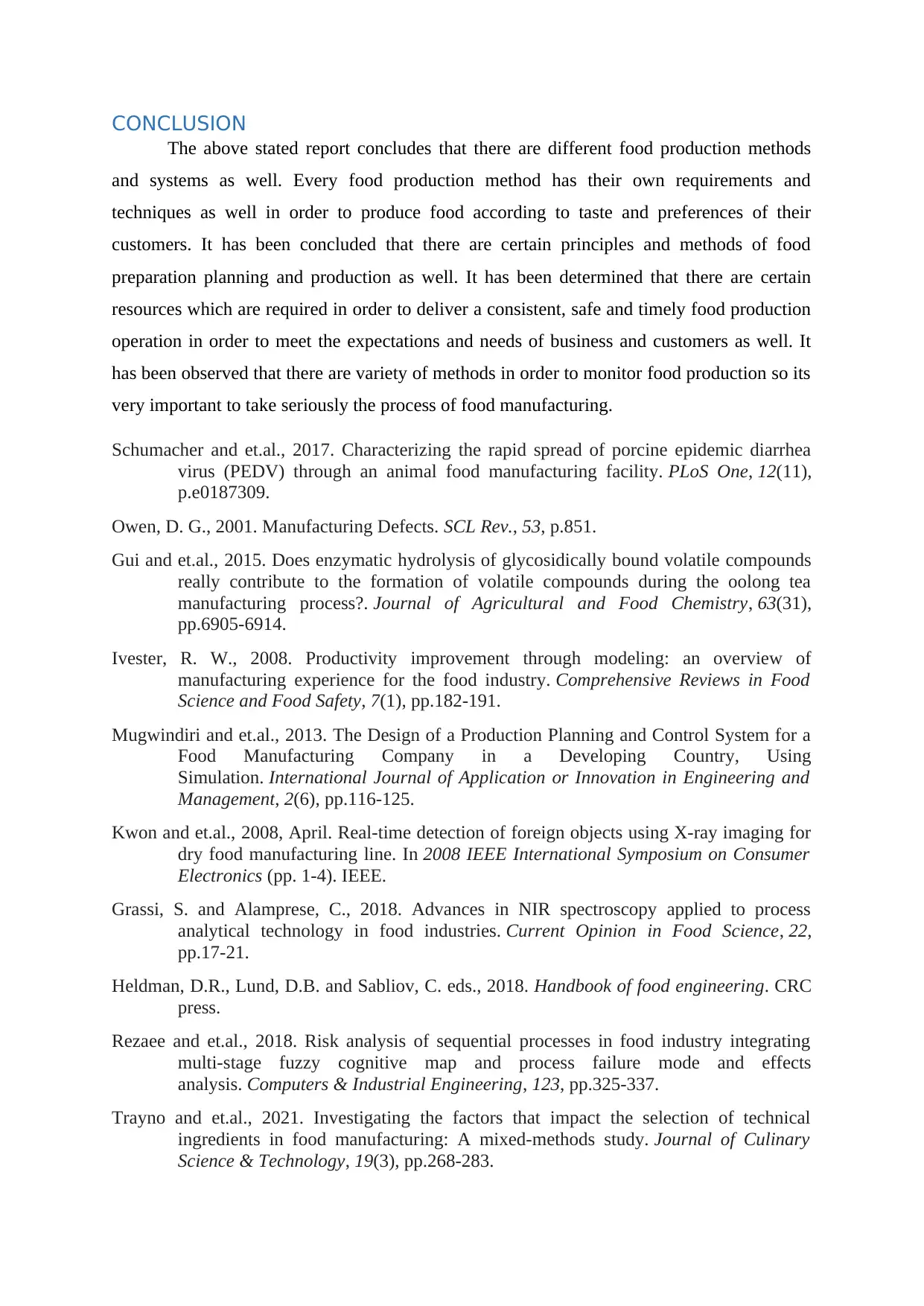
CONCLUSION
The above stated report concludes that there are different food production methods
and systems as well. Every food production method has their own requirements and
techniques as well in order to produce food according to taste and preferences of their
customers. It has been concluded that there are certain principles and methods of food
preparation planning and production as well. It has been determined that there are certain
resources which are required in order to deliver a consistent, safe and timely food production
operation in order to meet the expectations and needs of business and customers as well. It
has been observed that there are variety of methods in order to monitor food production so its
very important to take seriously the process of food manufacturing.
Schumacher and et.al., 2017. Characterizing the rapid spread of porcine epidemic diarrhea
virus (PEDV) through an animal food manufacturing facility. PLoS One, 12(11),
p.e0187309.
Owen, D. G., 2001. Manufacturing Defects. SCL Rev., 53, p.851.
Gui and et.al., 2015. Does enzymatic hydrolysis of glycosidically bound volatile compounds
really contribute to the formation of volatile compounds during the oolong tea
manufacturing process?. Journal of Agricultural and Food Chemistry, 63(31),
pp.6905-6914.
Ivester, R. W., 2008. Productivity improvement through modeling: an overview of
manufacturing experience for the food industry. Comprehensive Reviews in Food
Science and Food Safety, 7(1), pp.182-191.
Mugwindiri and et.al., 2013. The Design of a Production Planning and Control System for a
Food Manufacturing Company in a Developing Country, Using
Simulation. International Journal of Application or Innovation in Engineering and
Management, 2(6), pp.116-125.
Kwon and et.al., 2008, April. Real-time detection of foreign objects using X-ray imaging for
dry food manufacturing line. In 2008 IEEE International Symposium on Consumer
Electronics (pp. 1-4). IEEE.
Grassi, S. and Alamprese, C., 2018. Advances in NIR spectroscopy applied to process
analytical technology in food industries. Current Opinion in Food Science, 22,
pp.17-21.
Heldman, D.R., Lund, D.B. and Sabliov, C. eds., 2018. Handbook of food engineering. CRC
press.
Rezaee and et.al., 2018. Risk analysis of sequential processes in food industry integrating
multi-stage fuzzy cognitive map and process failure mode and effects
analysis. Computers & Industrial Engineering, 123, pp.325-337.
Trayno and et.al., 2021. Investigating the factors that impact the selection of technical
ingredients in food manufacturing: A mixed-methods study. Journal of Culinary
Science & Technology, 19(3), pp.268-283.
The above stated report concludes that there are different food production methods
and systems as well. Every food production method has their own requirements and
techniques as well in order to produce food according to taste and preferences of their
customers. It has been concluded that there are certain principles and methods of food
preparation planning and production as well. It has been determined that there are certain
resources which are required in order to deliver a consistent, safe and timely food production
operation in order to meet the expectations and needs of business and customers as well. It
has been observed that there are variety of methods in order to monitor food production so its
very important to take seriously the process of food manufacturing.
Schumacher and et.al., 2017. Characterizing the rapid spread of porcine epidemic diarrhea
virus (PEDV) through an animal food manufacturing facility. PLoS One, 12(11),
p.e0187309.
Owen, D. G., 2001. Manufacturing Defects. SCL Rev., 53, p.851.
Gui and et.al., 2015. Does enzymatic hydrolysis of glycosidically bound volatile compounds
really contribute to the formation of volatile compounds during the oolong tea
manufacturing process?. Journal of Agricultural and Food Chemistry, 63(31),
pp.6905-6914.
Ivester, R. W., 2008. Productivity improvement through modeling: an overview of
manufacturing experience for the food industry. Comprehensive Reviews in Food
Science and Food Safety, 7(1), pp.182-191.
Mugwindiri and et.al., 2013. The Design of a Production Planning and Control System for a
Food Manufacturing Company in a Developing Country, Using
Simulation. International Journal of Application or Innovation in Engineering and
Management, 2(6), pp.116-125.
Kwon and et.al., 2008, April. Real-time detection of foreign objects using X-ray imaging for
dry food manufacturing line. In 2008 IEEE International Symposium on Consumer
Electronics (pp. 1-4). IEEE.
Grassi, S. and Alamprese, C., 2018. Advances in NIR spectroscopy applied to process
analytical technology in food industries. Current Opinion in Food Science, 22,
pp.17-21.
Heldman, D.R., Lund, D.B. and Sabliov, C. eds., 2018. Handbook of food engineering. CRC
press.
Rezaee and et.al., 2018. Risk analysis of sequential processes in food industry integrating
multi-stage fuzzy cognitive map and process failure mode and effects
analysis. Computers & Industrial Engineering, 123, pp.325-337.
Trayno and et.al., 2021. Investigating the factors that impact the selection of technical
ingredients in food manufacturing: A mixed-methods study. Journal of Culinary
Science & Technology, 19(3), pp.268-283.
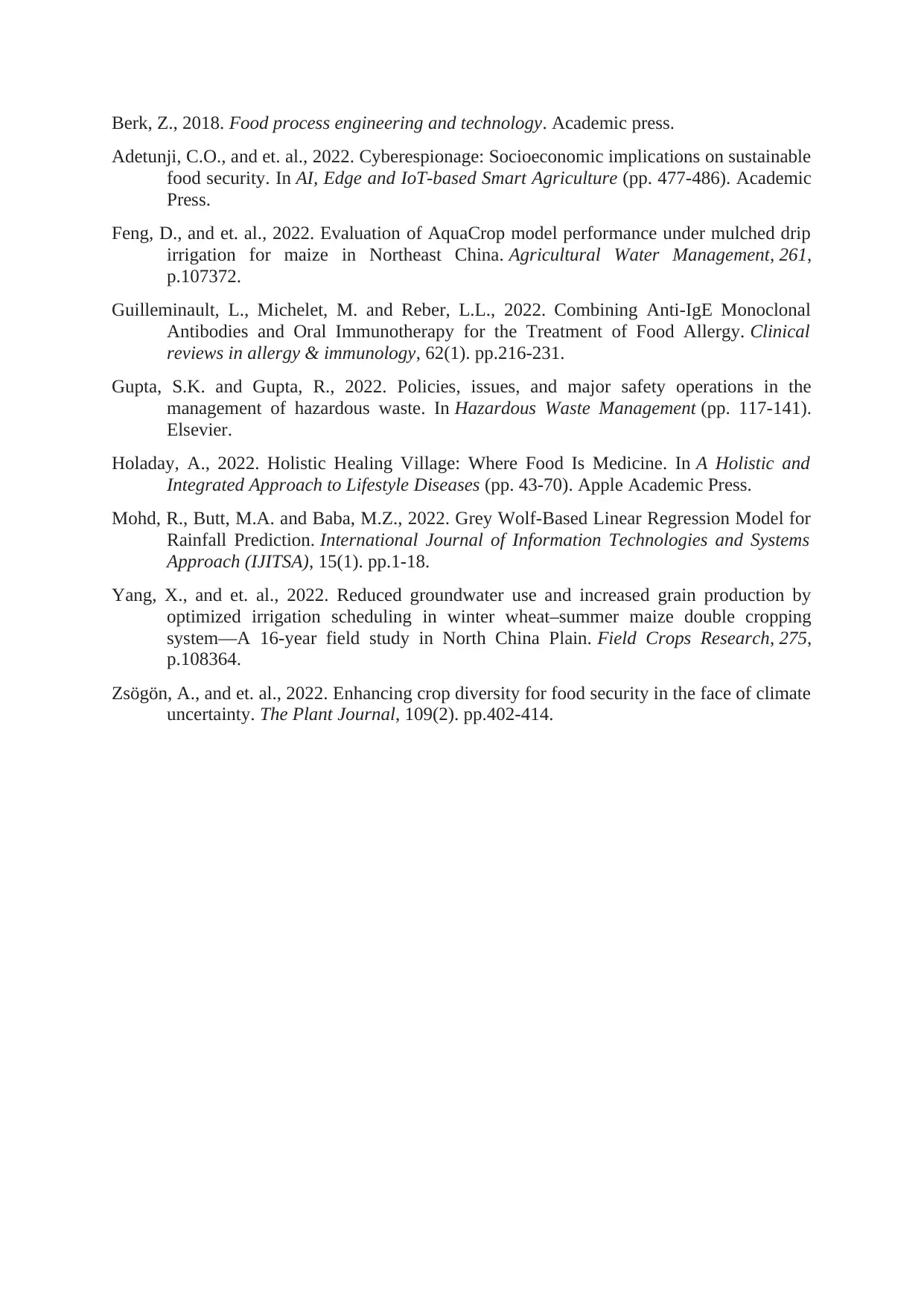
Berk, Z., 2018. Food process engineering and technology. Academic press.
Adetunji, C.O., and et. al., 2022. Cyberespionage: Socioeconomic implications on sustainable
food security. In AI, Edge and IoT-based Smart Agriculture (pp. 477-486). Academic
Press.
Feng, D., and et. al., 2022. Evaluation of AquaCrop model performance under mulched drip
irrigation for maize in Northeast China. Agricultural Water Management, 261,
p.107372.
Guilleminault, L., Michelet, M. and Reber, L.L., 2022. Combining Anti-IgE Monoclonal
Antibodies and Oral Immunotherapy for the Treatment of Food Allergy. Clinical
reviews in allergy & immunology, 62(1). pp.216-231.
Gupta, S.K. and Gupta, R., 2022. Policies, issues, and major safety operations in the
management of hazardous waste. In Hazardous Waste Management (pp. 117-141).
Elsevier.
Holaday, A., 2022. Holistic Healing Village: Where Food Is Medicine. In A Holistic and
Integrated Approach to Lifestyle Diseases (pp. 43-70). Apple Academic Press.
Mohd, R., Butt, M.A. and Baba, M.Z., 2022. Grey Wolf-Based Linear Regression Model for
Rainfall Prediction. International Journal of Information Technologies and Systems
Approach (IJITSA), 15(1). pp.1-18.
Yang, X., and et. al., 2022. Reduced groundwater use and increased grain production by
optimized irrigation scheduling in winter wheat–summer maize double cropping
system—A 16-year field study in North China Plain. Field Crops Research, 275,
p.108364.
Zsögön, A., and et. al., 2022. Enhancing crop diversity for food security in the face of climate
uncertainty. The Plant Journal, 109(2). pp.402-414.
Adetunji, C.O., and et. al., 2022. Cyberespionage: Socioeconomic implications on sustainable
food security. In AI, Edge and IoT-based Smart Agriculture (pp. 477-486). Academic
Press.
Feng, D., and et. al., 2022. Evaluation of AquaCrop model performance under mulched drip
irrigation for maize in Northeast China. Agricultural Water Management, 261,
p.107372.
Guilleminault, L., Michelet, M. and Reber, L.L., 2022. Combining Anti-IgE Monoclonal
Antibodies and Oral Immunotherapy for the Treatment of Food Allergy. Clinical
reviews in allergy & immunology, 62(1). pp.216-231.
Gupta, S.K. and Gupta, R., 2022. Policies, issues, and major safety operations in the
management of hazardous waste. In Hazardous Waste Management (pp. 117-141).
Elsevier.
Holaday, A., 2022. Holistic Healing Village: Where Food Is Medicine. In A Holistic and
Integrated Approach to Lifestyle Diseases (pp. 43-70). Apple Academic Press.
Mohd, R., Butt, M.A. and Baba, M.Z., 2022. Grey Wolf-Based Linear Regression Model for
Rainfall Prediction. International Journal of Information Technologies and Systems
Approach (IJITSA), 15(1). pp.1-18.
Yang, X., and et. al., 2022. Reduced groundwater use and increased grain production by
optimized irrigation scheduling in winter wheat–summer maize double cropping
system—A 16-year field study in North China Plain. Field Crops Research, 275,
p.108364.
Zsögön, A., and et. al., 2022. Enhancing crop diversity for food security in the face of climate
uncertainty. The Plant Journal, 109(2). pp.402-414.

Paraphrase This Document
Need a fresh take? Get an instant paraphrase of this document with our AI Paraphraser



1 out of 16
Related Documents
Your All-in-One AI-Powered Toolkit for Academic Success.
+13062052269
info@desklib.com
Available 24*7 on WhatsApp / Email
![[object Object]](/_next/static/media/star-bottom.7253800d.svg)
Unlock your academic potential
© 2024 | Zucol Services PVT LTD | All rights reserved.





